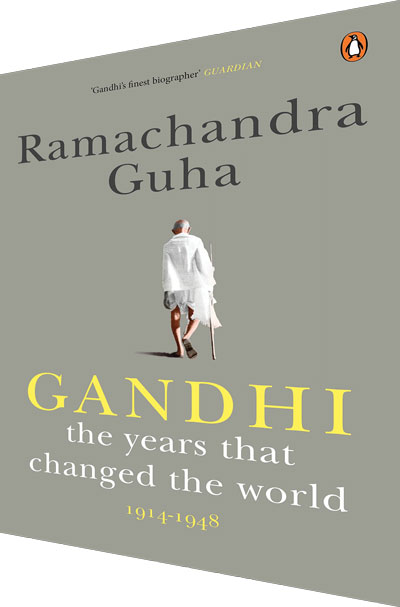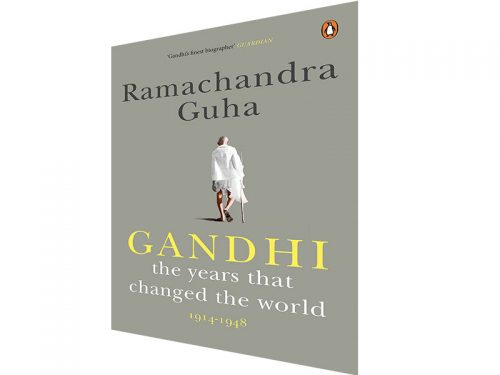Timely biography – Gandhi: The years that changed the world
Gandhi: The years that changed the world – Ramachandra Guha,
Penguin random house, Rs.980, Pages 1109

Surprisingly, this monumental 1,109-page biography of Mahatma Gandhi covering the years 1914 — when after having tried and tested the principles of ahimsa and satyagraha to attain political ends in South Africa, he returned to India — and 1948, the year of his martyrdom in the cause of Hindu-Muslim unity, has been sparsely reviewed and/or debated in the media or in public forums. Yet on October 2, the BJP-led NDA government at the Centre is set to pull out all stops to launch year-long celebrations to hosanna Gandhi’s sesquicentennial birth anniversary.
There is a palpable tinge of hypocrisy in the imminent BJP-led national celebrations of the Mahatma’s 150th birth anniversary. It’s pertinent to note that the man who assassinated Gandhi on January 30, 1948, five months after India and Pakistan became politically independent nations, was a card-carrying member of the Rashtriya Swayamsevak Sangh (RSS), proudly acknowledged by the BJP as its ideological mentor organisation. It’s also noteworthy that prime minister Narendra Modi is a proud, self-proclaimed pracharak (soldier) of the para-military RSS, which played a negligible role in the national independence movement.
Therefore, there is a clear and present danger that the Mahatma’s government-orchestrated sesquicentennial celebrations will focus on his peripheral messages — civic cleanliness and hygiene, cow protection, national language — rather than his core objectives, viz non-violence, self-sacrifice, eradication of caste discrimination, Hindu-Muslim harmony, gender equality, rural development and anti-consumerism.
The distinguishing feature of celebrated historian Ramachandra Guha’s latest Gandhi biography — he has authored two others — India after Gandhi — the History of the World’s Largest Democracy (2007) and Gandhi Before India (2013) — is that it is an almost day-to-day account of the Mahatma’s life from the time he returned to India from South Africa in 1914, to the day he was felled by three bullets fired by RSS pracharak and propagandist Nathuram Godse.
While most biographies of Gandhi centre on the milestone events of India’s freedom struggle and the critical role Gandhi played in them, Guha’s latest oeuvre is a detailed recitation of Gandhi’s political and personal life of 34 years after his return from the diaspora, India’s independence on August 15, 1947, and his assassination five months later. As such, it offers a history of India’s unique freedom struggle from the perspective of the ‘peace room’ of its mastermind and generalissimo.
The original intent of your reviewer was to read the most important of the 38 chapters of this tome, but once started it was impossible to skip any portions because the chapters meld into a fascinating step-by-step narrative of the evolution of M.K. Gandhi into Mahatma Gandhi, an unparalleled, inspirational leader about whom the scientist Albert Einstein famously wrote that “generations to come, it may be, will scarce believe that such a one as this ever in flesh and blood walked upon this earth”.
The first deep insight your correspondent has derived from this extensively researched and absorbing biography is that Gandhi understood the value of cultural symbolism in a largely illiterate and socio-economically backward society that India was — and has remained. In 1921, it was a difficult decision for a Middle Temple barrister to simplify his peasant’s attire of a shirt and dhoti into an ascetic loin cloth which left his upper body uncovered.
Although Guha faithfully reports that mysteriously informed crowds turned out even in the dead of night in the most obscure town of hinterland India for a darshan of this newly-emergent leader of the masses as he travelled across the subcontinent, the cause and effect of this symbolism is not sufficiently highlighted. The value that Gandhi attached to symbolism was also manifested by the Dandi Salt March (1930) when the issue of taxation of this common household item was amplified to protest the cruel imperialism of the British Raj. This brilliant symbolism and non-violent civil disobedience campaign against it, electrified the Indian masses.
Another reason behind Gandhi’s unprecedented popularity with the subjugated masses was the Mahatma’s extraordinary courage and determination. The author details five abnegating fasts undertaken by Gandhi for what he believed were crucial national issues which brought him to the brink of death. This quality of readiness to die for important causes made him more precious to the populace.
To the author’s credit, Gandhi: The years that changed the world also frankly recounts Gandhiji’s quirks and whims — sexual abstinence, food and nutrition fads as well as his somewhat bizarre sex experiments. But in retrospect, it’s clear this great soul believed that inner struggle and purification was a necessary precondition of successful political leadership. Because of his intense inner struggles and consequent development and articulation of the principles of non-violence, self-sacrifice and a messianic appeal for the unity of humanity which he not merely preached, but practised, Mahatma Gandhi succeeded in shaming the experienced leaders of imperial Great Britain who were forced to concede India’s independence in 1947 a mere 33 years after he took up the cause of purna swaraj (complete independence) in right earnest.
Yet as the nation led by the ruling BJP begins the Mahatma’s sesquicentennial anniversary, it is useful to recall and reiterate the importance of Gandhi’s legacy. “To deliver India from British rule was by no means Gandhi’s only preoccupation. The forging of harmonious relations between India’s often disputatious religious communities was a second. The desire to end the pernicious practice of untouchability in his own Hindu faith was a third. And an impulse to develop economic self-reliance for India and moral self-reliance for Indians was fourth. These campaigns were conducted in parallel. All were of equal importance to him,” writes Guha.
Unfortunately, in this age of fake news and ingenious political propaganda, there is a clear and present danger of these core objectives which shaped and drove the Mahatma’s life, being side-stepped and substituted with his less important messages.
Ex facie the title of this labour-of-love biography of India’s greatest son – Gandhi: The years that changed the world — Guha’s own great gift to India — may seem over the top. Yet it is pertinent to note that while great contemporaries who rubbished and disparaged Gandhi including viceroy Lord Willingdon who described him as “the biggest humbug alive” and Winston Churchill who dismissed him as a “half-naked fakir”, have disappeared into the footnotes of history, Mahatma Gandhi and his credo of non-violent resistance to administrative oppression inspired modern leaders such as Martin Luther King in the US and Nelson Mandela in South Africa. Even to this day, his life and message drives and motivates people and movements for freedom and justice as far afield as Egypt (Arab Spring revolt) and the youth of Hong Kong agitating against the communist regime of mainland China.
Unfortunately in contemporary India where assertion of Hindu majoritarianism, religious and caste discrimination, and neglect of the rural majority are becoming normative, the present generation is insufficiently aware that such a colossus in flesh and blood walked upon our native soil.
Dilip Thakore
















Add comment